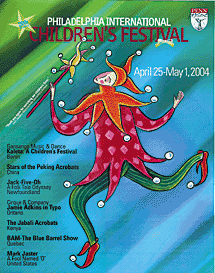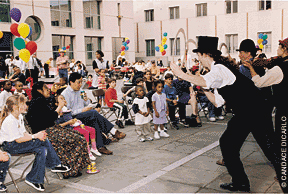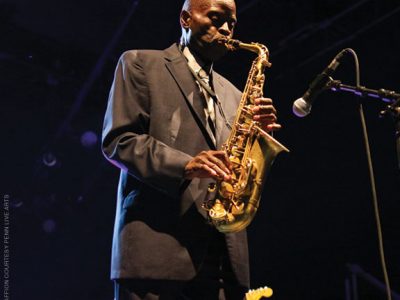
This spring, about 20,000 children, teachers, and parents attended a birthday party of sorts, featuring Chinese acrobats, a silent jester, and West African dancers. The Philadelphia International Children’s Festival (PICF), organized by the Annenberg Center for the Performing Arts, turned 20.
The oldest festival of its kind in the country, the PICF was the brainchild of Catherine “Kaki” Marshall CW’45, who served as its first director; she and Stephen Goff Ar’62, then the Annenberg Center’s managing director, launched it with financial assistance from the late Walter Annenberg W’31 Hon’66.
For the last 12 years Brian Joyce, who joined the PICF as a staff technician two decades ago, has been the festival’s director. He is now stepping down to pursue a new call, the Methodist ministry.
Shortly before his final festival opened on April 25, Joyce sat down with Gazette associate editor Susan Frith for an interview.

Did you start out with an interest in children’s theater?
No. My entire generation of theater professionals was trained with a tremendous loathing of children’s theater. I thought it was a failure. In fact, I still argue everywhere I go to speak that Americans [unlike people in other countries] view art for young people as a second-class profession.
Americans hate children and we hate childhood. We do everything in our power to make sure our children don’t have as nice of a childhood as we had. They have all kinds of things, but what we’re really doing is trying to sculpt little adults, so we can decide whether they get to be big, elite adults or whether they’re big, working adults. That’s what our school system is based on. But inside of the school system and inside of the arts are a lot of good people fighting against the general direction our culture is taking our children. When I realized that was the job, I said, “Yeah, sign me up.”
How do you decide which performances to bring to the festival?
I see what I like. Once you know it’s good art, then you just have to make the decision of whether or not it’s appropriate for children. I don’t want nihilistic children’s theater. I also want to make sure that if your child comes and sits in our festival, then he or she will be able to look at the stage and do two things: first, see themselves represented and second, see the stranger, the other, represented.
During your travels, you told me, you sometimes see 40 shows in two weeks. Don’t you get sick of previewing that many productions?
The most transcendental, marvelous moments of my life have been sitting in theaters around the world. [But] I expect to hate the majority of work I see. I expect to despise one thing on every trip. There was a night in the Netherlands when the lights came up and there was a giant playpen on stage and a 65-year-old bald man in a diaper. I knew I was in trouble then. There was a Mexican Communist puppeteer whose entire piece was about how much America destroyed Mexico, which, my politics aside, doesn’t make for good puppetry.
That’s counting out the [bad] American work. Sojourner Truth is owed an apology by the number of mediocre performers who have portrayed her life. It’s mytho-historic. And its whole point is to fill in the spot on the paper where you check the box for “Yes, they’ve seen something during Black History Month.”
Tell me about a moment when you were blown away by a performance.
There was a French-Canadian piece, Tale of Tikka, a two-character piece about violence to children as it’s passed down through the generations. And this piece is the most hopeful, beautiful piece of theater. I left the theater and walked from the harbor front where I saw it to my hotel three miles away in the freezing cold, just weeping.
Is pedagogy always a bad thing in children’s theater?
My objection to arts in education is very simple: You have not this year gone to see anything and said to the person you were with, “Let’s go see this. I think it will educate us.” That’s not why you love art. When children’s performing arts bows to education as if it’s the one reason art should exist in the lives of children, then what you get is pedagogical theater. I have seen more plays in my life about looking both ways before you cross the street. Now trust me: that’s not an important play.
Plays are about the fullness of life. And yet we want these linear, simplistic pieces that teach our children things that they should be taught at home.
How would you describe this year’s festival?
Festivals are actually sort of historical documents [because they] reflect an international mood among performing artists. This festival is a response to 9/11, to terrorism and the destabilization of international relations. It’s filled with shows that say that childhood is still an innocent, lovely place to be. People want to go to the theater and have the lights go down and have joy on the stage, because we’re down. The world is unsure.
Any behind-the-scenes stories?
The best story has to do with visas and a company formed in Uganda, after the civil war, by war orphans. Our visa-request forms ask you for an exact date of birth, but this company only responded with years. So I got up on my American high horse. I called the company back and said, “You haven’t given me all the information I need.”
And I got a letter back that made me feel as wretched as I’d ever felt in my entire life, because he explained apologetically that they were going to go back to the villages and see if anyone remembered close to when each child was born, but that most of the people in the village were dead and they don’t remember the days.
I worked every angle I could to get the visas. At the last minute they still had problems at the American Embassy in Uganda. The woman who worked there told the group’s leader, “There are 17 of you. I have to know you’re not trying to … become illegal immigrants. Somehow all of you have to prove to me that you’re artists.” He had his people turn the chairs and ashtrays over, and they drummed the show on chairs and ashtrays while these women danced in the waiting room. At the end of the performance, the whole room was weeping, and she signed them off and sent them away.




